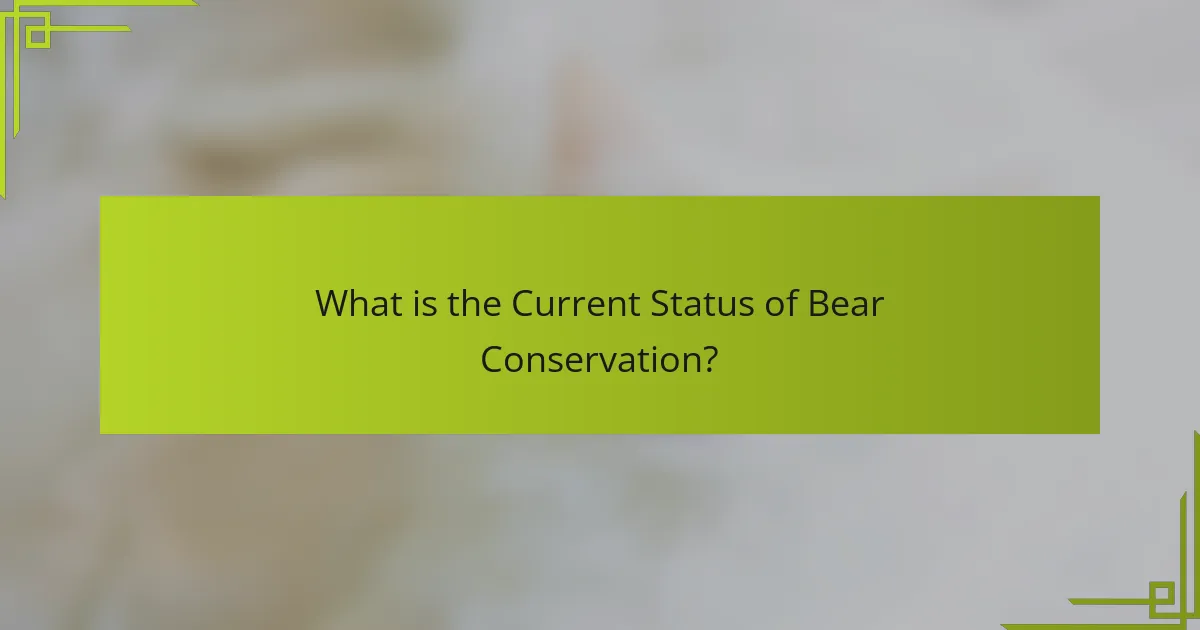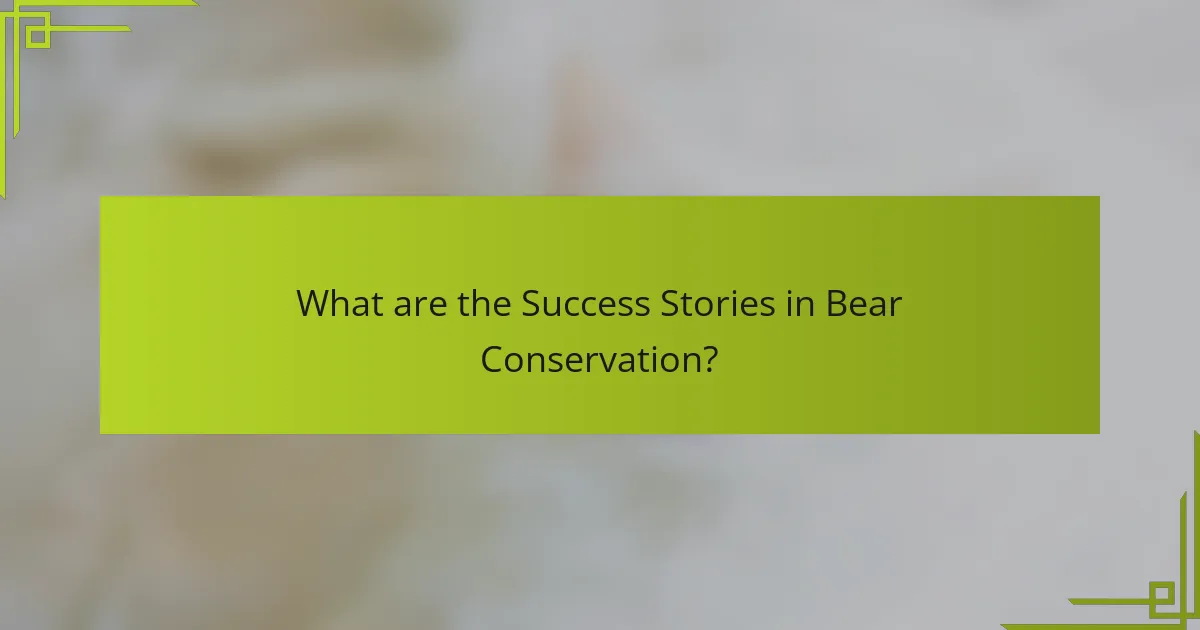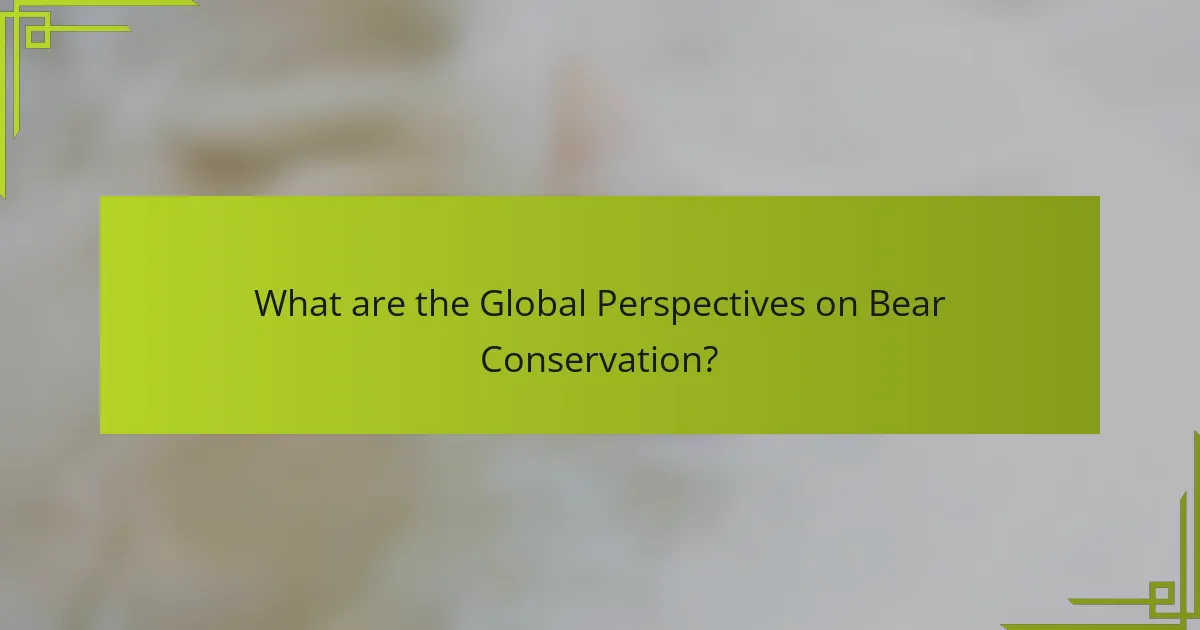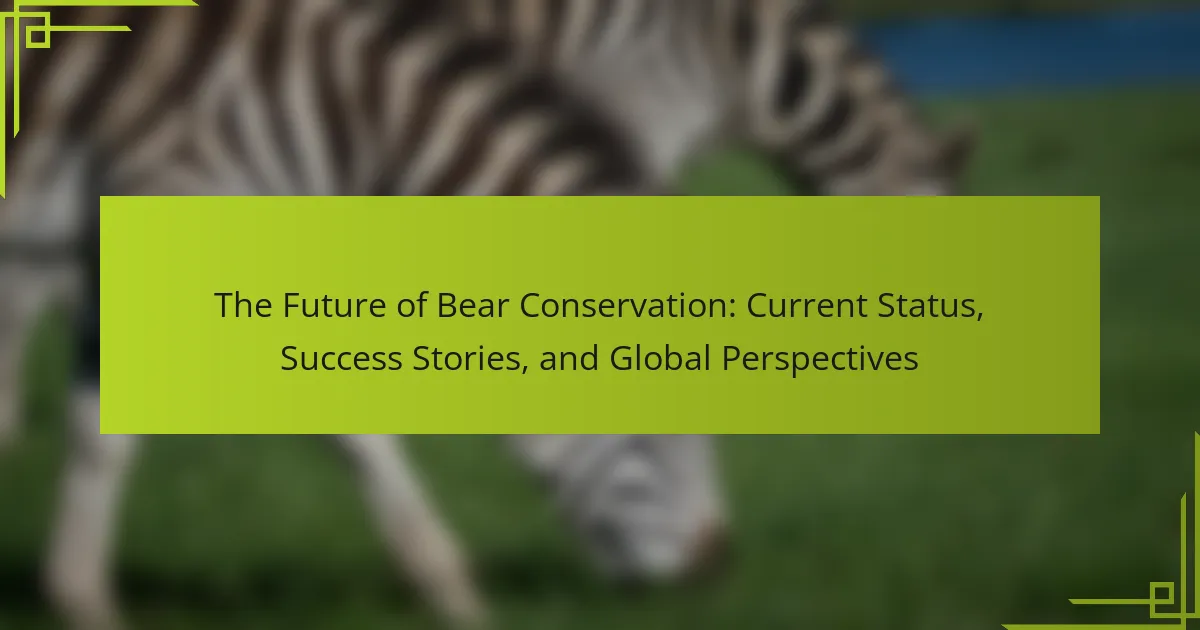Bear conservation encompasses efforts to protect various bear species, many of which are classified as vulnerable or endangered by the IUCN Red List. This article examines the current status of bear conservation, highlighting both successes and ongoing challenges across different regions. It details notable recovery stories, such as the American black bear and giant panda, as well as the positive trends in brown bear populations in Europe. Furthermore, the article discusses global perspectives on bear conservation, focusing on strategies employed in North America, Europe, and Asia, including habitat preservation, community engagement, and international collaboration. Overall, it underscores the importance of continued conservation efforts to ensure the survival of bear species worldwide.

What is the Current Status of Bear Conservation?
The current status of bear conservation shows both progress and challenges. Various species of bears are protected under international agreements. For instance, the IUCN Red List categorizes certain bear species as vulnerable or endangered. Conservation efforts include habitat protection, anti-poaching initiatives, and community engagement. In North America, black bear populations are stable due to management practices. However, polar bears face threats from climate change and habitat loss. In Asia, the illegal wildlife trade poses significant risks to certain bear species. Overall, while some bear populations are recovering, many still require ongoing conservation efforts.
Why is bear conservation important for biodiversity?
Bear conservation is crucial for biodiversity because bears play a significant role as apex predators and keystone species in their ecosystems. They help regulate prey populations, which maintains a balance in the food web. This regulation prevents overgrazing and supports plant diversity. Furthermore, bears contribute to nutrient cycling through their foraging habits. When bears consume fruits and disperse seeds, they promote forest regeneration. Their presence also influences the behavior of other species, fostering a diverse community. The decline of bear populations can lead to cascading effects on ecosystem health and resilience. Protecting bears ensures the stability of various habitats and the species that depend on them.
What role do bears play in their ecosystems?
Bears play a crucial role in their ecosystems as apex predators and keystone species. They help regulate prey populations, which maintains balance within the food web. By foraging for fruits and nuts, bears also aid in seed dispersal, promoting plant diversity. Their digging activities aerate the soil, enhancing nutrient cycling. Bears contribute to nutrient redistribution through their waste, enriching the soil and supporting various plant species. Studies show that areas with healthy bear populations exhibit greater biodiversity. Overall, bears are essential for ecosystem health and resilience.
How do bears impact other species and habitats?
Bears impact other species and habitats primarily through their roles as apex predators and keystone species. Their predation helps regulate populations of herbivores and smaller carnivores. This regulation maintains plant diversity and ecosystem balance. Bears also contribute to nutrient cycling. When they consume salmon, for example, they transport nutrients from aquatic to terrestrial environments through their droppings. This enriches the soil and supports plant growth. Additionally, bear dens provide habitats for other species, such as insects and small mammals. Their foraging behavior creates disturbances that can promote biodiversity. Research shows that areas with healthy bear populations tend to have greater ecological stability.
What are the main threats to bear populations today?
The main threats to bear populations today include habitat loss, climate change, poaching, and human-wildlife conflict. Habitat loss occurs due to urban development and deforestation, which reduces the space bears need to live and find food. Climate change affects bears by altering their habitats and food sources, impacting their survival. Poaching remains a significant threat, as bears are hunted for their body parts and as trophies. Human-wildlife conflict arises when bears venture into human settlements in search of food, leading to negative interactions. According to the International Union for Conservation of Nature (IUCN), these factors contribute to the decline of several bear species worldwide.
How does habitat loss affect bear conservation efforts?
Habitat loss significantly undermines bear conservation efforts. It reduces the available space for bears to live, hunt, and reproduce. Deforestation, urban development, and climate change are primary causes of habitat loss. These changes lead to fragmented populations, making it difficult for bears to find mates. Reduced genetic diversity can result from isolated populations. Furthermore, habitat loss increases human-bear conflicts as bears search for food in urban areas. According to the World Wildlife Fund, habitat destruction is one of the leading threats to bear species worldwide. Effective conservation strategies must address habitat preservation and restoration to ensure bear populations thrive.
What impact does climate change have on bear habitats?
Climate change significantly impacts bear habitats. It alters temperature and precipitation patterns, affecting food availability. For example, melting ice in polar regions reduces the habitat for polar bears. Increased temperatures can lead to habitat loss for species like the grizzly bear. Wildfires, driven by climate change, destroy forest habitats essential for many bear species. Changes in plant growth cycles disrupt the food chain, impacting bear populations. Additionally, shifting ecosystems may force bears into closer contact with humans, leading to conflicts. These factors collectively threaten the survival of bear populations globally.
How does poaching influence bear population dynamics?
Poaching significantly reduces bear populations. It leads to decreased [censured] bear numbers, which disrupts population stability. The removal of breeding individuals affects reproduction rates. This can result in fewer cubs surviving to adulthood. Additionally, poaching can create an imbalance in [censured] ratios. Such imbalances hinder successful breeding. Research indicates that poaching contributes to population declines in various bear species. For example, the International Union for Conservation of Nature reports that poaching threatens species like the Asiatic black bear. This highlights the critical impact of poaching on bear population dynamics.

What are the Success Stories in Bear Conservation?
Success stories in bear conservation include the recovery of the American black bear population. In the early 20th century, habitat loss and hunting drastically reduced their numbers. Conservation efforts, including habitat protection and regulated hunting, have led to population rebounds. For instance, in the 1970s, the American black bear population was estimated at around 100,000. Today, estimates suggest their numbers exceed 600,000 across North America.
Another success story is the rehabilitation of the giant panda. Once classified as endangered, concerted conservation efforts increased their population from about 1,000 in the 1990s to over 1,800 today. Habitat preservation and breeding programs have played a crucial role in this recovery.
In Europe, the brown bear population has also seen positive trends. Countries like Italy and Slovenia have implemented effective management strategies. These include habitat restoration and legal protections, resulting in stable or increasing bear populations.
These examples illustrate that strategic conservation efforts can lead to significant recoveries in bear populations worldwide.
Which countries have made significant strides in bear conservation?
Countries that have made significant strides in bear conservation include the United States, Canada, and Sweden. The United States has implemented the Endangered Species Act, which protects several bear species. Canada has established numerous national parks and wildlife reserves, contributing to bear habitat preservation. Sweden has enforced strict hunting regulations and promotes coexistence between bears and humans. These countries have seen population recoveries in certain bear species as a result of these efforts.
What specific programs have been effective in these countries?
It is not possible to provide a definitive answer regarding specific programs effective in bear conservation across various countries without additional context or details about the countries in question. Each country may have unique programs tailored to their specific bear species and conservation challenges. Therefore, a general answer cannot be formulated accurately.
How have local communities contributed to these successes?
Local communities have played a crucial role in the successes of bear conservation efforts. They have engaged in habitat protection initiatives that directly benefit bear populations. Community-led education programs have raised awareness about the importance of bears in ecosystems. In many regions, local people have participated in monitoring bear populations, providing valuable data for conservation strategies. Collaborative efforts between communities and conservation organizations have led to sustainable practices that reduce human-bear conflicts. Economic incentives, such as eco-tourism, have motivated communities to protect bears rather than exploit them. These contributions have been essential in fostering a culture of conservation and ensuring the long-term survival of bear species.
What innovative strategies have emerged in bear conservation?
Innovative strategies in bear conservation include the use of technology, community engagement, and habitat restoration. Technology such as GPS tracking allows researchers to monitor bear movements and behaviors in real time. This data helps in understanding bear populations and their habitat needs. Community engagement initiatives involve local populations in conservation efforts, fostering a sense of ownership and responsibility. Programs that educate communities about bears reduce human-bear conflicts. Habitat restoration focuses on creating and preserving natural environments where bears can thrive. These strategies have shown positive results in various regions, demonstrating their effectiveness in bear conservation efforts.
How has technology influenced bear monitoring and protection?
Technology has significantly influenced bear monitoring and protection through advanced tracking and data collection methods. GPS collars allow researchers to monitor bear movements in real-time. These collars provide precise location data, enhancing understanding of bear behavior and habitat use. Camera traps capture images of bears, aiding in population estimates and health assessments. Drones are utilized for aerial surveys, covering vast areas efficiently. Acoustic monitoring detects bear vocalizations, contributing to behavioral studies. Data analytics processes large datasets, identifying patterns in bear populations. These technological advancements improve conservation strategies and enhance human-bear coexistence efforts.
What role do wildlife corridors play in conservation success?
Wildlife corridors play a crucial role in conservation success by facilitating animal movement between fragmented habitats. They help maintain genetic diversity by allowing species to interbreed. This movement reduces the risk of inbreeding depression, which can threaten population viability. Corridors also enable animals to access food, water, and breeding sites, essential for survival. Studies show that wildlife corridors can increase species richness in connected areas. For example, the Yellowstone to Yukon Conservation Initiative illustrates successful corridor implementation. This initiative has improved bear populations by linking habitats across vast distances. Overall, wildlife corridors are vital for enhancing ecosystem resilience and supporting biodiversity.

What are the Global Perspectives on Bear Conservation?
Global perspectives on bear conservation vary significantly across regions. In North America, conservation efforts focus on habitat preservation and managing human-bear interactions. The U.S. Fish and Wildlife Service has implemented recovery plans for endangered species like the grizzly bear. In Europe, countries emphasize coexistence strategies to mitigate conflicts between bears and livestock. The European Union’s Bear Action Plan aims to protect populations while promoting sustainable tourism. In Asia, particularly in China, conservation is driven by cultural values and the need to preserve biodiversity. Local organizations work to educate communities about the ecological importance of bears. Collaborative international efforts, such as the Global Bear Conservation Initiative, bring together multiple countries to share knowledge and resources. These diverse approaches reflect the unique challenges and cultural contexts of bear conservation worldwide.
How do cultural attitudes towards bears affect conservation efforts?
Cultural attitudes towards bears significantly influence conservation efforts. Positive cultural perceptions can lead to increased support for conservation initiatives. For instance, in regions where bears are viewed as symbols of strength or nature, communities often engage in protective measures. Conversely, negative attitudes, such as fear or viewing bears as pests, can result in opposition to conservation policies. Research shows that local beliefs about bears can dictate funding and resources allocated for their protection. In North America, Indigenous cultures often promote coexistence with bears, enhancing conservation success. Overall, cultural context shapes public engagement and policy development in bear conservation efforts.
What are some examples of positive cultural representations of bears?
Bears are often positively represented in various cultures. In Native American culture, bears symbolize strength, courage, and leadership. They are frequently depicted in stories and art as wise and protective figures. In many Asian cultures, such as in Japan, bears are seen as symbols of bravery and endurance. The teddy bear has become a universal symbol of comfort and childhood innocence in Western cultures. Additionally, bears are celebrated in folklore, such as in the story of Goldilocks and the Three Bears, which portrays them as gentle and family-oriented. These representations contribute to a positive perception of bears in cultural narratives.
How can negative perceptions of bears hinder conservation initiatives?
Negative perceptions of bears can significantly hinder conservation initiatives. These perceptions often stem from fear and misunderstanding of bear behavior. When people view bears as threats, they may oppose conservation efforts. This opposition can lead to reduced funding and support for habitat protection. Additionally, negative views can result in increased hunting and culling of bear populations. Studies show that communities with positive attitudes towards bears are more likely to support conservation programs. For example, the International Bear Association highlights that education can shift perceptions and foster coexistence. Without addressing negative perceptions, conservation initiatives may struggle to gain community backing.
What international collaborations exist for bear conservation?
International collaborations for bear conservation include the Bear Specialist Group, part of the International Union for Conservation of Nature (IUCN). This group unites experts globally to share knowledge and strategies for bear protection. Another collaboration is the World Wildlife Fund (WWF), which works on various bear conservation projects worldwide. The Global Bear Conservation Network also facilitates partnerships among organizations focused on bear conservation. Additionally, the Polar Bear Conservation Plan involves multiple countries to protect polar bear habitats. These collaborations aim to address threats to bear populations and promote sustainable practices.
How do treaties and agreements facilitate global bear protection?
Treaties and agreements facilitate global bear protection by establishing legal frameworks for conservation efforts. They promote international cooperation among countries to address threats to bear populations. For example, the Convention on International Trade in Endangered Species (CITES) regulates trade in bear species to prevent over-exploitation. Additionally, regional agreements like the Memorandum of Understanding on the Conservation of Bears in Europe foster collaborative conservation strategies. These treaties often include guidelines for habitat protection, research funding, and public awareness initiatives. As a result, they help ensure the survival of bear species across different ecosystems.
What role do NGOs play in international bear conservation efforts?
NGOs play a crucial role in international bear conservation efforts. They engage in habitat protection, anti-poaching initiatives, and community education. NGOs often collaborate with local governments and international organizations. They provide funding and resources for research on bear populations. For example, organizations like the World Wildlife Fund conduct studies on bear habitats. They also advocate for policies that protect bear species and their environments. By raising public awareness, NGOs influence conservation efforts at multiple levels. Their involvement has led to successful recovery programs for several bear species globally.
What can individuals do to support bear conservation?
Individuals can support bear conservation by participating in habitat protection initiatives. This can include volunteering for local conservation organizations focused on preserving bear habitats. Individuals can also reduce their carbon footprint to mitigate climate change, which affects bear populations. Educating others about bear conservation is another effective method. This raises awareness and promotes responsible behavior towards wildlife. Supporting legislation that protects bears and their habitats is crucial. Donations to wildlife conservation funds can provide essential resources for research and protection efforts. Lastly, individuals should practice responsible outdoor activities, such as properly storing food when camping to avoid attracting bears.
How can education and awareness campaigns make a difference?
Education and awareness campaigns can significantly enhance bear conservation efforts. These initiatives inform the public about the importance of bears in ecosystems. They also highlight the threats bears face, such as habitat loss and poaching. Increased knowledge can lead to greater public support for protective measures. For instance, campaigns can encourage responsible tourism practices. This reduces human-bear conflicts and promotes coexistence. Research shows that communities engaged in awareness programs report higher levels of conservation action. A study by the World Wildlife Fund found that local awareness efforts increased bear population stability in key areas. Thus, education and awareness campaigns are vital for fostering a culture of conservation.
What practical steps can people take to contribute to conservation efforts?
People can contribute to conservation efforts by adopting sustainable practices. Reducing energy consumption lowers carbon footprints. Supporting local conservation organizations provides funding and resources. Participating in clean-up events helps restore habitats. Educating others about wildlife conservation raises awareness. Choosing sustainable products reduces demand for harmful practices. Advocating for policies that protect natural habitats influences decision-makers. Volunteering time for conservation projects directly aids in preservation efforts.
The main entity of this article is bear conservation, which encompasses the current status, success stories, and global perspectives on the protection of bear species. The article outlines the progress made in bear conservation, including stable populations of certain species like the American black bear, while highlighting ongoing challenges such as habitat loss, climate change, and poaching. It discusses the ecological importance of bears as apex predators and keystone species, the threats they face, and successful conservation efforts across various countries. Additionally, the article emphasizes the role of local communities, innovative strategies, and international collaborations in enhancing bear conservation initiatives.
